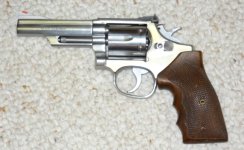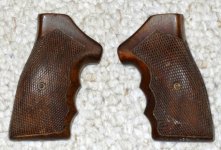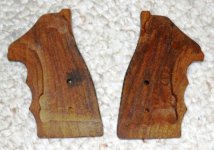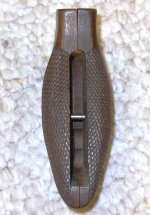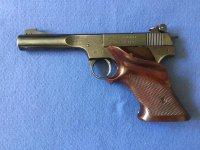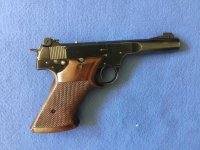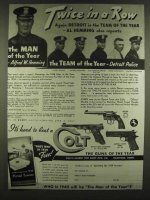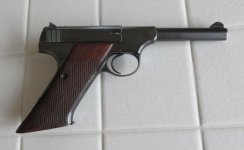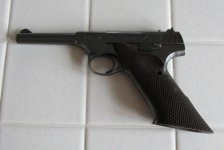DRAFT in progress…
Vintage Custom Stocks/Grips by Gagne, Sanderson, Farrant, Hurst…
I am assembling another reference guide to assist in the identification of various custom grip manufacturers. The intent of this thread is to provide links, photos, and general information on various grip makers and their respective designs and not necessarily to conduct a comprehensive review on any one craftsman or style. I have provided links to threads which go into much more detail on individual craftsman. Lastly, I chose the manufacturers below as they seem to generate the most debate regarding identification/verification. I do not mean any disrespect to current craftsman such as Mr. Brown, Culina, Spegel, Ahrends, but they are still producing new grips and are kind enough to sign/label their work.
I have provided photos of grips I own (owned), and I unfortunately do not own examples of every maker. So, please feel free to include photos of your favorite examples and other productive information.
You may be interested in my prior thread: Smith & Wesson N Frame Stocks / Grips – A Reference Guide
Smith & Wesson N Frame Stocks / Grips - A Reference Guide
Walter Roper – Mathias Gagne
Well-known firearms writer, shooter, and enthusiast Walter Roper hired Mathias Gagne to make custom designed stocks from the mid-30's into the early 50s. Today examples of Gagne's craftsmanship are simply called "Ropers" due to the characteristic design/style of Walter's design.
While the design, features, and shape of “Roper” stocks are pretty distinctive, each set was custom made and like any craftsman there appears to be subtle changes in the production of these grips. As a result, vintage "Roper" style grips are probably the most debated when it comes to identifying and authenticating the work of Gagne, if possible. Various elements such as the quality, shape, tool/jig marks, diamond checkering, wood type/grain, and age, must be assessed.
Commonly discussed features used in identifying Roper style grips:
• The presence of a small square or rectangular "jig" hole on the inside of each grips panel is probable the most cited characteristic of vintage examples. However, there are also examples that appear to be genuine Gagne “Ropers” that do not have a jig hole present.
• The presence of a diamond and ribbon checkering pattern used on many examples in what has been coined “Roper” stocks. However, the shape, size, location of the checkering must all be assessed.
• They usually lack figure or distinctive grain and Walnut was the most commonly used wood type. The wood can vary from plain to fancy, and a few exotic wood pairs are known. This is mostly attributed to cost, availability, and workability/stability of plain tight grain wood. (See article excerpt below)
• Numbers or description of the gun which the grips fit can be penciled/carved into the inside of each panel
• Other considerations: screw escutcheon, contour of wood at trigger guard, checkering (border, LPI, size, shape, etc.), finger grooves, palm swell….
Per the 1952 article written on Mr. Mathias Gagne “Orders come to the 84-year-old carver by mail…in which outlines of the hand drawn to scale are sent. These outlines are used by Gagne for his dimensions and shaping of the handles. Also the letter explains which eye the customer aims with, as well as any peculiarities of shooting habits. Most popular among the woods used for the handles is American Walnut, although he said Caucasian walnut was most demanded when it was available up to last year. Other types of wood he noted, frequently requested were black ebony, mahogany, Birdseye maple, cherry, Lignum Vitae and even mesquite wood mainly by Texans…He went on to say wood must be very dense, solid, and preferably heavy. Many customers send imported woods in which they wish their handles to be carved. Gagne works in his shop alone, but said he employed tow local men until World War II…Extensive and elaborate designs are worked into the gun handles and the finished product is produced after about three or four days work on an average order. He added that often he makes tools needed for certain operations.” See link… A little something for Roper fans....article now added thanks to Mr. Wilson
Lastly, Mathias and his son Albert Gagne (who worked for S&W) are often credited by many for influencing the design of postwar Target Stocks as well as the “Coke” style Target Stocks introduced for the .44 Magnum revolver.
K-Frame Roper Thumbrest Target Stocks. Very Nicely Grained.



K-Frame Roper Thumbrest Target Stocks. Contoured, large checkering coverage, closed-back stocks, slight palm swell and finger-grooves along the front. Note how the stocks contour forward towards the trigger guard, another characteristic of "Ropers".





N-Frame Roper Birdseye Maple Target - These are unique in shape in that they are best described as short Target Stocks which just cover the grip frame with no horn or thumbrest, and extend forward towards the trigger guard. In my opinion, Gagne put a lot of detail into how his grips extended towards and contoured the trigger guard.




M-frame LadySmith Target Stocks with features comparable and indicative of Roper/Gagne stocks but no jig-holes, medallions (very rare to have medallions in Gagne stocks), arrow checkering style is unusual or not cited to Gagne and exotic zebrawood. However, the quality, shape, diamond center checkering, bordering around the back grip-frame, contour of the trigger guard, and carved numbers on the inside are consistent with Gagne's craftsmanship. Therefore, it remains a mystery who the maker of these grips was but these are a decent example of the various characteristics that must be assessed when looking at vintage custom stocks.



http://smith-wessonforum.com/s-w-ha...-grips-couple-guns.html?510115=#post139470742
Show your Roper grips
http://smith-wessonforum.com/s-w-ha...ot-ropers-question.html?486825=#post139222923
K frame Ropers
Kearsage - Charles Wendell
Prewar Kearsage grips made by Charles Wendell of Massachusetts.
Kearsage vs. Roper
LAPD – California Custom Grip Craftsman
Walter Stark, Fuzzy Farrant, Guy Hogue, John Hurst, Joe Blackford, Arthur Kanthack
Custon Grips Part 3 - Walter Rickell on Farrant & Custom Handguns
http://smith-wessonforum.com/s-w-ha...ollection-pictures.html?130557=#post135405676
Stocks by Hurst
John Hurst
Hurst grips can often be found with Yellow pencil/chalk on the inside with a large number while a few sets were signed by him. He often used either a circle or 'fat' elongated diamond center checking pattern. In my experience, he used the "circle" shape around the screw escutcheon more than others, I recall seeing Guy Hogue use this same style but by and large they are going to be examples of Hurst's work. Hurst also used a circular cutout in the front of several of his large Target grips to access the strain screw. He may have the most pronounced palm swell and curves of these various custom grip makers, particularly towards the bottom. Nearly every set I’ve owned has exact matching “bookend” grain.
J-frame round butt & K frame square butt Hurst grips.





N-Frame Square Butt Target Stocks




Stocks by Hurst
http://smith-wessonforum.com/s-w-re...bats-post140020602.html?557602=#post140020602
http://smith-wessonforum.com/s-w-ha...urst-target-stocks.html?388284=#post138037418
http://smith-wessonforum.com/s-w-re...sq-checkered-grips.html?507858=#post139452443
Earl “Fuzzy” Farrant
Farrant grips often found with marker/pencil markings of numbers, frame size, type “TGT”, found in small font on the inside. He is known for his palm swell and characteristic shape/design. His grips can be found with palm swell (left, right, both) and/or checkering (left, right, both). Generally speaking, the other makers either used checkering on both panels or none, so if you have checkering on one side it may be Farrant’s work. Farrant's grips seem to taper from thick to thin (top to bottom) and are wider (front to back).
K/L Frame Round Butt



N Frames:





http://smith-wessonforum.com/s-w-ha...nt-custom-handguns.html?130545=#post135405600
http://smith-wessonforum.com/s-w-re...zzy-farrant-stocks.html?394409=#post138113260
Guy Hogue
Founder of the famed "Hogue" grip company. Early original wood target grips have the same/similar shape or contour of today's wood and rubber grips produced by the company.
http://smith-wessonforum.com/s-w-ha...ollection-pictures.html?130557=#post135405676
http://smith-wessonforum.com/s-w-re...y-told-they-fuzzys.html?477122=#post139109805
Sanderson – Lew Sanderson, Don Sanderson
Well-known for his thumbrest target grips. Sanderson grips can be most readily identified via numerical stampings on the inside of his grips. These numbers were for inventory/order tracking purposes while they were made. A common characteristic of his stocks is the large cutout along the lower front to access the strain screw. Based in Michigan.
N-Frame Thumbrest Walnut Stocks - "4" stamped inside.



The Ultimate Sanderson Stock Appreciation Thread (Post Your Stocks!!!!)
http://smith-wessonforum.com/s-w-re...56-sanderson-grips.html?182656=#post135869437
http://smith-wessonforum.com/s-w-ha...erson-stocks-grips.html?298288=#post137018640
Cloyce
Very unique circular and ribbon checkering designs and some heavily contoured/shaped stocks. Appears to have used a circle shaped jig hole identified on the inside of his stocks. Based in Idaho.
http://smith-wessonforum.com/s-w-ha...yce-stocks-i-think.html?470066=#post139023726
http://smith-wessonforum.com/lounge...-yours-add-history.html?444128=#post138700479
Other related links:
http://smith-wessonforum.com/s-w-ha...chief-davis-k-38-a.html?130333=#post135403789
http://smith-wessonforum.com/s-w-ha...tom-handgun-stocks.html?130719=#post135407254
http://smith-wessonforum.com/s-w-ha...un-stocks-part-1-a.html?130109=#post135403800
Vintage Custom Stocks/Grips by Gagne, Sanderson, Farrant, Hurst…
I am assembling another reference guide to assist in the identification of various custom grip manufacturers. The intent of this thread is to provide links, photos, and general information on various grip makers and their respective designs and not necessarily to conduct a comprehensive review on any one craftsman or style. I have provided links to threads which go into much more detail on individual craftsman. Lastly, I chose the manufacturers below as they seem to generate the most debate regarding identification/verification. I do not mean any disrespect to current craftsman such as Mr. Brown, Culina, Spegel, Ahrends, but they are still producing new grips and are kind enough to sign/label their work.
I have provided photos of grips I own (owned), and I unfortunately do not own examples of every maker. So, please feel free to include photos of your favorite examples and other productive information.
You may be interested in my prior thread: Smith & Wesson N Frame Stocks / Grips – A Reference Guide
Smith & Wesson N Frame Stocks / Grips - A Reference Guide
Walter Roper – Mathias Gagne
Well-known firearms writer, shooter, and enthusiast Walter Roper hired Mathias Gagne to make custom designed stocks from the mid-30's into the early 50s. Today examples of Gagne's craftsmanship are simply called "Ropers" due to the characteristic design/style of Walter's design.
While the design, features, and shape of “Roper” stocks are pretty distinctive, each set was custom made and like any craftsman there appears to be subtle changes in the production of these grips. As a result, vintage "Roper" style grips are probably the most debated when it comes to identifying and authenticating the work of Gagne, if possible. Various elements such as the quality, shape, tool/jig marks, diamond checkering, wood type/grain, and age, must be assessed.
Commonly discussed features used in identifying Roper style grips:
• The presence of a small square or rectangular "jig" hole on the inside of each grips panel is probable the most cited characteristic of vintage examples. However, there are also examples that appear to be genuine Gagne “Ropers” that do not have a jig hole present.
• The presence of a diamond and ribbon checkering pattern used on many examples in what has been coined “Roper” stocks. However, the shape, size, location of the checkering must all be assessed.
• They usually lack figure or distinctive grain and Walnut was the most commonly used wood type. The wood can vary from plain to fancy, and a few exotic wood pairs are known. This is mostly attributed to cost, availability, and workability/stability of plain tight grain wood. (See article excerpt below)
• Numbers or description of the gun which the grips fit can be penciled/carved into the inside of each panel
• Other considerations: screw escutcheon, contour of wood at trigger guard, checkering (border, LPI, size, shape, etc.), finger grooves, palm swell….
Per the 1952 article written on Mr. Mathias Gagne “Orders come to the 84-year-old carver by mail…in which outlines of the hand drawn to scale are sent. These outlines are used by Gagne for his dimensions and shaping of the handles. Also the letter explains which eye the customer aims with, as well as any peculiarities of shooting habits. Most popular among the woods used for the handles is American Walnut, although he said Caucasian walnut was most demanded when it was available up to last year. Other types of wood he noted, frequently requested were black ebony, mahogany, Birdseye maple, cherry, Lignum Vitae and even mesquite wood mainly by Texans…He went on to say wood must be very dense, solid, and preferably heavy. Many customers send imported woods in which they wish their handles to be carved. Gagne works in his shop alone, but said he employed tow local men until World War II…Extensive and elaborate designs are worked into the gun handles and the finished product is produced after about three or four days work on an average order. He added that often he makes tools needed for certain operations.” See link… A little something for Roper fans....article now added thanks to Mr. Wilson
Lastly, Mathias and his son Albert Gagne (who worked for S&W) are often credited by many for influencing the design of postwar Target Stocks as well as the “Coke” style Target Stocks introduced for the .44 Magnum revolver.
K-Frame Roper Thumbrest Target Stocks. Very Nicely Grained.



K-Frame Roper Thumbrest Target Stocks. Contoured, large checkering coverage, closed-back stocks, slight palm swell and finger-grooves along the front. Note how the stocks contour forward towards the trigger guard, another characteristic of "Ropers".





N-Frame Roper Birdseye Maple Target - These are unique in shape in that they are best described as short Target Stocks which just cover the grip frame with no horn or thumbrest, and extend forward towards the trigger guard. In my opinion, Gagne put a lot of detail into how his grips extended towards and contoured the trigger guard.




M-frame LadySmith Target Stocks with features comparable and indicative of Roper/Gagne stocks but no jig-holes, medallions (very rare to have medallions in Gagne stocks), arrow checkering style is unusual or not cited to Gagne and exotic zebrawood. However, the quality, shape, diamond center checkering, bordering around the back grip-frame, contour of the trigger guard, and carved numbers on the inside are consistent with Gagne's craftsmanship. Therefore, it remains a mystery who the maker of these grips was but these are a decent example of the various characteristics that must be assessed when looking at vintage custom stocks.



http://smith-wessonforum.com/s-w-ha...-grips-couple-guns.html?510115=#post139470742
Show your Roper grips
http://smith-wessonforum.com/s-w-ha...ot-ropers-question.html?486825=#post139222923
K frame Ropers
Kearsage - Charles Wendell
Prewar Kearsage grips made by Charles Wendell of Massachusetts.
Kearsage vs. Roper
LAPD – California Custom Grip Craftsman
Walter Stark, Fuzzy Farrant, Guy Hogue, John Hurst, Joe Blackford, Arthur Kanthack
Custon Grips Part 3 - Walter Rickell on Farrant & Custom Handguns
http://smith-wessonforum.com/s-w-ha...ollection-pictures.html?130557=#post135405676
Stocks by Hurst
John Hurst
Hurst grips can often be found with Yellow pencil/chalk on the inside with a large number while a few sets were signed by him. He often used either a circle or 'fat' elongated diamond center checking pattern. In my experience, he used the "circle" shape around the screw escutcheon more than others, I recall seeing Guy Hogue use this same style but by and large they are going to be examples of Hurst's work. Hurst also used a circular cutout in the front of several of his large Target grips to access the strain screw. He may have the most pronounced palm swell and curves of these various custom grip makers, particularly towards the bottom. Nearly every set I’ve owned has exact matching “bookend” grain.
J-frame round butt & K frame square butt Hurst grips.





N-Frame Square Butt Target Stocks




Stocks by Hurst
http://smith-wessonforum.com/s-w-re...bats-post140020602.html?557602=#post140020602
http://smith-wessonforum.com/s-w-ha...urst-target-stocks.html?388284=#post138037418
http://smith-wessonforum.com/s-w-re...sq-checkered-grips.html?507858=#post139452443
Earl “Fuzzy” Farrant
Farrant grips often found with marker/pencil markings of numbers, frame size, type “TGT”, found in small font on the inside. He is known for his palm swell and characteristic shape/design. His grips can be found with palm swell (left, right, both) and/or checkering (left, right, both). Generally speaking, the other makers either used checkering on both panels or none, so if you have checkering on one side it may be Farrant’s work. Farrant's grips seem to taper from thick to thin (top to bottom) and are wider (front to back).
K/L Frame Round Butt



N Frames:





http://smith-wessonforum.com/s-w-ha...nt-custom-handguns.html?130545=#post135405600
http://smith-wessonforum.com/s-w-re...zzy-farrant-stocks.html?394409=#post138113260
Guy Hogue
Founder of the famed "Hogue" grip company. Early original wood target grips have the same/similar shape or contour of today's wood and rubber grips produced by the company.
http://smith-wessonforum.com/s-w-ha...ollection-pictures.html?130557=#post135405676
http://smith-wessonforum.com/s-w-re...y-told-they-fuzzys.html?477122=#post139109805
Sanderson – Lew Sanderson, Don Sanderson
Well-known for his thumbrest target grips. Sanderson grips can be most readily identified via numerical stampings on the inside of his grips. These numbers were for inventory/order tracking purposes while they were made. A common characteristic of his stocks is the large cutout along the lower front to access the strain screw. Based in Michigan.
N-Frame Thumbrest Walnut Stocks - "4" stamped inside.



The Ultimate Sanderson Stock Appreciation Thread (Post Your Stocks!!!!)
http://smith-wessonforum.com/s-w-re...56-sanderson-grips.html?182656=#post135869437
http://smith-wessonforum.com/s-w-ha...erson-stocks-grips.html?298288=#post137018640
Cloyce
Very unique circular and ribbon checkering designs and some heavily contoured/shaped stocks. Appears to have used a circle shaped jig hole identified on the inside of his stocks. Based in Idaho.
http://smith-wessonforum.com/s-w-ha...yce-stocks-i-think.html?470066=#post139023726
http://smith-wessonforum.com/lounge...-yours-add-history.html?444128=#post138700479
Other related links:
http://smith-wessonforum.com/s-w-ha...chief-davis-k-38-a.html?130333=#post135403789
http://smith-wessonforum.com/s-w-ha...tom-handgun-stocks.html?130719=#post135407254
http://smith-wessonforum.com/s-w-ha...un-stocks-part-1-a.html?130109=#post135403800
Last edited:

